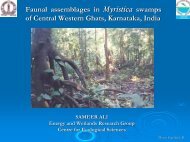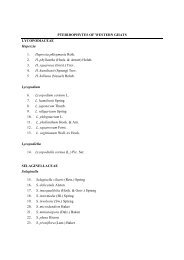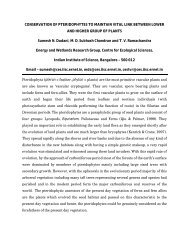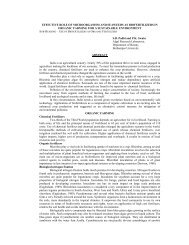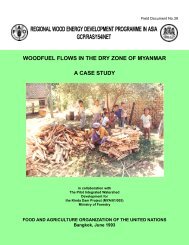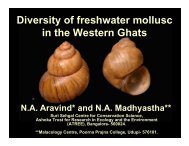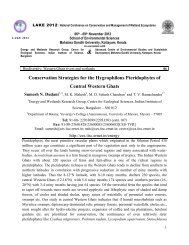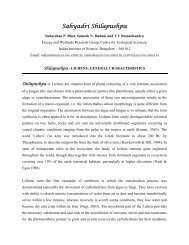The diatom genus Gomphonema Ehrenberg in India: Checklist and ...
The diatom genus Gomphonema Ehrenberg in India: Checklist and ...
The diatom genus Gomphonema Ehrenberg in India: Checklist and ...
You also want an ePaper? Increase the reach of your titles
YUMPU automatically turns print PDFs into web optimized ePapers that Google loves.
Introduction<br />
<strong>The</strong> <strong>diatom</strong> <strong>genus</strong> <strong>Gomphonema</strong> <strong>Ehrenberg</strong> is large, <strong>in</strong>clud<strong>in</strong>g over 500 taxa<br />
worldwide (Fourtanier & Kociolek 2009). While its members are almost exclusively<br />
freshwater <strong>in</strong> terms of habitats, <strong>and</strong> many species are associated with impacted trophic<br />
levels (e.g. Patrick <strong>in</strong> Patrick & Reimer 1966), the <strong>genus</strong> is quite diverse morphologically.<br />
Variation <strong>in</strong> valve ultrastructure <strong>in</strong>cludes presence or absence of stigmata,<br />
areolar structure, structure <strong>and</strong> position of the apical pore fields, <strong>and</strong> presence/absence<br />
of sp<strong>in</strong>es to name a few (Kociolek & Stoermer 1993, but also see Metzelt<strong>in</strong> &<br />
Lange-Bertalot 1998, Reichardt 1999). While some species of <strong>Gomphonema</strong> appear<br />
to be cosmopolitan <strong>in</strong> their distribution (for example, it appears that G. parvulum<br />
(Kütz<strong>in</strong>g) Kütz<strong>in</strong>g has been reported from all cont<strong>in</strong>ents on earth), there are many<br />
reports of endemic species of <strong>Gomphonema</strong> from South America (Fricke 1904;<br />
Metzelt<strong>in</strong> & Lange-Bertalot 2007), Africa (Compère 1995, Hustedt 1949, Kociolek<br />
& Stoermer 1991), Madagascar (Spauld<strong>in</strong>g & Kociolek 1998), North America<br />
(Kociolek & K<strong>in</strong>gston 1999, Thomas et al. 2009), Europe (Hustedt 1945, Reichardt<br />
1999, 2005), Asia (Lange-Bertalot & Genkal 1999, Li et al. 2006) <strong>and</strong> Australia <strong>and</strong><br />
environs (Hustedt 1942, Kociolek et al. 2004).<br />
<strong>India</strong> is a large, geographically complex country with ten different biogeographic<br />
zones cover<strong>in</strong>g over 3 million sq. km, about a third the size of all of Europe, but<br />
with nearly 50% greater human population (World Population Prospects, 2008).<br />
<strong>The</strong> country shares borders with Bangladesh, Bhutan, Myanmar, Ch<strong>in</strong>a, Nepal <strong>and</strong><br />
Pakistan. <strong>The</strong> complexity of <strong>India</strong>’s freshwater environments <strong>in</strong>cludes three major,<br />
complex watersheds (Himalayas <strong>and</strong> the Karakoram ranges; V<strong>in</strong>dhya, Satpura ranges<br />
<strong>and</strong> the Chota Nagpur Plateau; <strong>and</strong> the Western Ghats) that cut across the country,<br />
related to their sources <strong>in</strong> the mounta<strong>in</strong>s. Freshwater environments range <strong>in</strong> elevation<br />
from sea level at the coast to over 8000 m above sea level.<br />
<strong>The</strong> <strong>diatom</strong> <strong>genus</strong> <strong>Gomphonema</strong> <strong>in</strong> <strong>India</strong> has been documented for over 160 years.<br />
First report of the <strong>genus</strong> <strong>in</strong> <strong>India</strong> was by <strong>Ehrenberg</strong> (1845), who reported G. clavatum,<br />
G. gracile <strong>and</strong> G. turris from "Kolkatta" (then Calcutta) <strong>and</strong> River Ganges. S<strong>in</strong>ce<br />
then, 49 separate papers have identified 130 taxa of <strong>Gomphonema</strong> from <strong>India</strong>, mostly<br />
from lowl<strong>and</strong> habitats. Of these, about 30% have been newly described taxa. In the<br />
region around <strong>India</strong>, gomphonemoid <strong>diatom</strong>s have been considered by Hustedt (1922),<br />
Jüttner et al. (2004) from Nepal, <strong>and</strong> Mereschkowsky (1906), Kociolek (1992), <strong>and</strong><br />
Li et al. (2006, <strong>in</strong> press) from Ch<strong>in</strong>a. Though many species of <strong>Gomphonema</strong> have<br />
been described from <strong>India</strong>, there are extensive parts of the country that have not<br />
been <strong>in</strong>vestigated. <strong>The</strong> Western Ghats mounta<strong>in</strong> range <strong>in</strong> Southern <strong>India</strong>, one of the<br />
Gondwanal<strong>and</strong> breakup l<strong>and</strong>masses, is amongst the most important hotspots of<br />
biodiversity. Western Ghats is a cha<strong>in</strong> of mounta<strong>in</strong>s that runs parallel with the west<br />
coast of <strong>India</strong> for over 1600 km from 8°15'N to 21°00'N. Due to its dist<strong>in</strong>ct<br />
physiographic, edaphic <strong>and</strong> climatic gradients, this region harbors a wide array of<br />
habitats with unique geographic position <strong>and</strong> that support unique sets of flora <strong>and</strong><br />
fauna. <strong>The</strong> Western Ghats harbors approximately 5000 species of vascular plants<br />
belong<strong>in</strong>g to nearly 2200 genera; about 1700 species (34%) are endemic. <strong>The</strong>re are<br />
also 58 endemic plant genera, while nearly three-quarters of the endemic genera<br />
212



